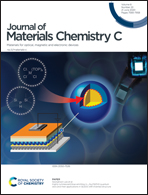Triazole functionalized 5,9-dioxa-13b-boranaphtho[3,2,1-de]anthracene: a new family of multi-stimuli responsive materials†
Abstract
A series of N-heterocycle-tethered organoboranes B1–B5 were synthesized and fully characterized. All these compounds contain a robust 5,9-dioxa-13b-boranaphtho[3,2,1-de]anthracene (DBNA) core which plays a role as a Lewis acid site. Study of the different N-heterocycles as Lewis base moieties reveals that n-butyl-1H-1,2,4-triazolyl functionalized compounds (B1–B3) exhibit the dynamic switching of the intermolecular B–N bond in response to heat stimulus, leading to unusual reversible emission intensity enhancement at elevated temperature, while n-hexyl-1H-1,2,3-triazolyl attached compounds (B4–B5) only display thermal emission quenching behaviors. The different stimuli-responsive properties in solutions may be attributed to the position of the substituent alkyl chains which influence the torsion of the molecules, leading to different affinity of intermolecular B–N interactions. Single crystal X-ray diffraction analysis further confirms the dimeric species formation of B1–B3 in solid state. Furthermore, all compounds exhibit good mechanochromism.
![Graphical abstract: Triazole functionalized 5,9-dioxa-13b-boranaphtho[3,2,1-de]anthracene: a new family of multi-stimuli responsive materials](/en/Image/Get?imageInfo.ImageType=GA&imageInfo.ImageIdentifier.ManuscriptID=D0TC00865F&imageInfo.ImageIdentifier.Year=2020)


 Please wait while we load your content...
Please wait while we load your content...